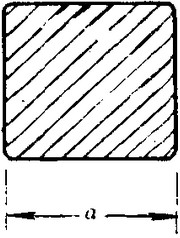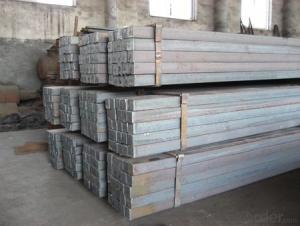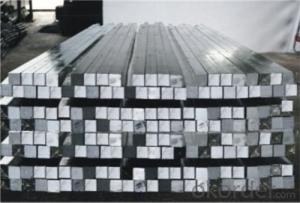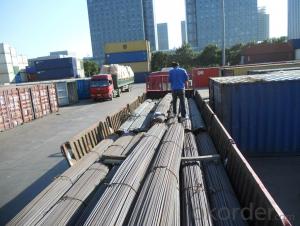High Quality GB Standard Steel Square Bar 63mm-80mm
- Loading Port:
- Tianjin
- Payment Terms:
- TT OR LC
- Min Order Qty:
- 25 m.t
- Supply Capability:
- 10000 m.t/month
OKorder Service Pledge
OKorder Financial Service
You Might Also Like
Product Description:
We offer Square Steel Bar with grade Q195 / Q235
Specifications of Square Steel Bar:
-Standard: GB,
-Grade: Q195/Q235 or equivalent.
Chemical Composition:
-Chemical Composition. Q195
Standard | Grade | Element (%) | ||||
GB | Q195 | C | Mn | S | P | Si |
0.06~0.12 | 0.25~0.50 | ≤0.050 | ≤0.045 | ≤0.30 | ||
-Chemical Composition. Q235
Standard | Grade | Element (%) | ||||
GB | Q235B | C | Mn | S | P | Si |
0.12~0.20 | 0.30~0.70 | ≤0.045 | ≤0.045 | ≤0.30 | ||
Measures and Tolerances of Square Steel Bar:

(The section of Square Steel Bar)
-The length of a side and the theoretical weight of Square Steel.
Length of a side(a, mm) | Theoretical weight(kg/m) | Length of a side(a, mm) | Theoretical weight(kg/m) |
6 | 0.283 | 32 | 8.04 |
7 | 0.385 | *33 | 8.55 |
8 | 0.502 | 34 | 9.07 |
9 | 0.636 | *35 | 9.62 |
10 | 0.785 | 36 | 10.17 |
11 | 0.950 | 38 | 11.24 |
12 | 1.13 | 40 | 12.56 |
13 | 1.33 | 42 | 13.85 |
14 | 1.54 | 45 | 15.90 |
15 | 1.77 | 48 | 18.09 |
16 | 2.01 | 50 | 19.63 |
17 | 2.27 | 53 | 22.05 |
18 | 2.54 | *55 | 23.6 |
19 | 2.82 | 56 | 24.61 |
20 | 3.14 | *58 | 26.4 |
21 | 3.46 | 60 | 28.26 |
22 | 3.80 | 63 | 31.16 |
*23 | 4.15 | *65 | 33.17 |
24 | 4.52 | *68 | 36.3 |
25 | 4.91 | 79 | 38.49 |
26 | 5.30 | 75 | 44.16 |
*27 | 5.72 | 80 | 50.24 |
28 | 6.15 | 85 | 56.72 |
*29 | 6.60 | 90 | 63.59 |
30 | 7.06 | 95 | 70.85 |
*31 | 7.54 | 100 | 78.50 |
Notes:
1, The theoretical weights in the list, base on the density of 7.85 g/cm3.
2, The numbers with *mean that they are not regulars or we don’t offer them.
-The allowed tolerance of Square Steel:
Length of a side(mm) | Allowed Tolerance | ||
Group1 | Group2 | Group3 | |
5.5~7 | ±0.20 | ±0.30 | ±0.40 |
7~20 | ±0.25 | ±0.35 | ±0.40 |
20~30 | ±0.30 | ±0.40 | ±0.50 |
30~50 | ±0.40 | ±0.50 | ±0.60 |
60~80 | ±0.60 | ±0.70 | ±0.80 |
80~110 | ±0.90 | ±1.0 | ±1.1 |
110~150 | ±1.2 | ±1.3 | ±1.1 |
150~190 | ―― | ―― | ±2.0 |
190~250 | ―― | ―― | ±2.5 |
Usage/Applications of Steel Square Bar:
-The Square Steel is normally used as structure steel.
-Row material for other structure steel like steel angles, channels, I-beams, H-beams, etc…
Packaging & Delivery of Steel Square Bar:
-Packing Detail: The products can be packed in bundles by steel wires.
-Marks:
1, Tag marks: the tag marks will be tied up to each bundle of the products. The information is usually including supplier’s logo and name, product name, made in China, products’ specifications, the painted color and other information requested by customers.
2, Color marks: we will paint both ends of the bundles of these products to make sure that they are more evident. It’s will be more convenient for the customers to distinguish them at the destination port.
-Delivery Detail: 30~45 working days after receive buyer’s T.T. or L/C.
Transportation:
-The products can be delivered by bulk vessel or by container. As for container, products with the length of 6m will be loaded in 20’ container, with 9m or 12m, in 40’ container.
-The maximum quantity of loading of container is 25 tons.
-The products usually are transported to the nearest port from the production place.
- Q:Can a steel square be used for checking the alignment of a belt sander table?
- Yes, a steel square can be used for checking the alignment of a belt sander table. The square's straight edge can be placed against the table and used to ensure that it is perfectly parallel to the belt sander's direction of movement. This method helps to ensure accurate and precise sanding results.
- Q:How do you use a steel square to find the correct angle for a miter joint?
- To use a steel square to find the correct angle for a miter joint, you would place the square against the edge of the workpiece with one arm extending along the face and the other arm perpendicular to it. Then, you can adjust the position of the square until the desired angle is formed at the intersection of the two arms. This angle can then be transferred or marked onto the workpiece to guide the cutting or joining process for the miter joint.
- Q:How do you use a steel square to measure and mark mitered angles?
- To achieve accurate measurements and markings when using a steel square to measure and mark mitered angles, follow these steps: 1. Prioritize cleaning your steel square thoroughly, removing any debris or rust. This will guarantee precise measurements and markings. 2. Determine the specific mitered angle you wish to create. For instance, let's assume we desire a 45-degree mitered angle. 3. Position the steel square against the material you are working with, aligning one edge of the square with the material's edge. 4. While keeping the square aligned with the material, rotate it until the desired angle (in this case, 45 degrees) aligns with the material's edge. 5. Once you have successfully aligned the desired angle, use a pencil or scribe to mark a line along the square's edge. This line will serve as a guide for your miter cut. 6. Repeat this process on the other piece of material you intend to miter, ensuring precise alignment of the square and accurate marking of the line. 7. Once both pieces are marked, proceed to use a miter saw or handsaw to cut along the marked lines, ensuring the preservation of the angle and the creation of a precise and clean mitered joint. Always remember to double-check your measurements and markings before making any cuts to ensure utmost accuracy. The utilization of a steel square to measure and mark mitered angles requires practice and precision.
- Q:Can a steel square be used for checking the alignment of a planer table?
- Yes, a steel square can be used for checking the alignment of a planer table. A steel square is a versatile tool that is commonly used in woodworking and construction for measuring and checking angles, as well as testing for squareness and alignment. To check the alignment of a planer table, you can place the steel square against the edge of the table and make sure it is flush with the surface. By visually inspecting the square against the table, you can determine if the table is aligned properly or if it needs adjustment. Additionally, you can use the steel square to check the alignment of the fence or other components of the planer to ensure accuracy and precision in your woodworking projects.
- Q:How do you use a steel square to determine the slope of a staircase?
- To use a steel square to determine the slope of a staircase, you would first need to understand the basic layout and structure of the staircase. 1. Begin by placing the steel square at the bottom of the staircase, with one arm (blade) resting against the vertical face of the first step. 2. Ensure that the square is perfectly level by adjusting it until the bubble in the level is centered. 3. Next, tilt the square so that the blade is parallel to the incline of the staircase. This means that the blade should be touching the nosing (the edge of the step that overhangs). 4. Take note of the number or measurement displayed on the scale of the steel square where the tongue (the shorter arm) intersects the tread (the horizontal surface of the step). This measurement represents the rise of the staircase. 5. Similarly, move the steel square up to the next step, aligning the blade with the vertical face and tilting it parallel to the incline. Again, note the measurement where the tongue intersects the tread, which represents the rise of the second step. 6. Repeat this process for each step, recording the rise for every step in order to determine the overall slope of the staircase. 7. To calculate the slope, divide the total rise of the staircase by the total run (the horizontal distance covered by the staircase). The resulting ratio will determine the slope of the staircase. It's important to note that using a steel square to determine the slope of a staircase is a basic method and may not provide the most accurate measurement. For more precise calculations, it's recommended to use specialized tools or consult with professionals in the field.
- Q:How do you use a steel square to measure and mark out mitered joints?
- To use a steel square for measuring and marking out mitered joints, you can follow these steps: 1. Start by ensuring that the edges of the steel square are clean and straight. 2. Place the steel square on the workpiece, aligning one edge of the square with the end of the first piece that will form the mitered joint. 3. With a pencil or marking knife, trace along the inside edge of the other side of the square, marking the desired angle for the mitered joint. 4. Repeat the same process on the other end of the workpiece to mark the corresponding angle. 5. Once both angles are marked, use a miter saw or a coping saw to cut along the marked lines, ensuring accuracy. 6. After cutting, fit the two pieces together to check the accuracy of the mitered joint. 7. Adjust as needed and make any necessary modifications until the joint fits tightly and accurately. 8. Finally, secure the mitered joint with appropriate fasteners, such as screws, nails, or dowels, depending on the project requirements. Remember to practice caution when using cutting tools and always wear appropriate safety gear to prevent accidents.
- Q:How do you use a steel square to lay out a compound miter cut?
- To use a steel square to lay out a compound miter cut, you need to understand the angles and measurements involved. First, determine the desired angle for the miter cut. Then, use the square to mark a 90-degree angle on the edge of the material. Next, align the square's long edge with the desired angle line on the material, making sure the blade of the square intersects the 90-degree line. Finally, mark the cut line along the square's blade, ensuring it aligns with the desired miter angle. This method helps in accurately marking the compound miter cut before making the actual cut.
- Q:Can a steel square be used for carpentry tasks?
- Yes, a steel square can be used for carpentry tasks. It is a versatile tool that can be used for measuring, marking, and checking angles in carpentry projects. Its durability and precision make it suitable for various tasks, such as laying out and cutting accurate angles, checking for squareness, and marking straight lines.
- Q:Can a steel square be used for checking the squareness of window jambs?
- Yes, a steel square can be used for checking the squareness of window jambs. A steel square is a versatile tool that is commonly used in carpentry and construction for checking the squareness of various objects including window jambs. By placing the steel square against the corners of the window jamb, one can determine if the corners are perfectly perpendicular or if there are any discrepancies. If the steel square is aligned perfectly with the corners, then the window jamb is considered square. However, if there are gaps or inconsistencies, adjustments may need to be made to ensure proper installation and fit of the window. Overall, a steel square is a reliable tool that can be used effectively for checking the squareness of window jambs.
- Q:Are there any safety considerations when using a steel square?
- Yes, there are several safety considerations when using a steel square. Firstly, it is important to handle the steel square with care, as it can have sharp edges and corners that can cause injuries if mishandled. It is advisable to wear protective gloves when using a steel square to avoid cuts or abrasions. Additionally, when using a steel square for measuring or marking purposes, it is essential to ensure that the square is properly aligned and positioned. Incorrect alignment can lead to inaccurate measurements or markings, which can result in errors in construction or other related tasks. Moreover, when using a steel square in conjunction with other tools or equipment, it is crucial to exercise caution and follow proper safety protocols. For example, if using a steel square with a saw or other cutting tools, it is important to maintain a safe distance between hands and the blade to prevent accidental injuries. Lastly, it is essential to store the steel square in a safe and organized manner when not in use. This includes properly securing it to avoid accidental falls or tripping hazards. It is also recommended to regularly inspect the steel square for any signs of damage or wear that may compromise its structural integrity and safety. Overall, by being mindful of these safety considerations, one can effectively and safely use a steel square in various applications.
1. Manufacturer Overview |
|
|---|---|
| Location | |
| Year Established | |
| Annual Output Value | |
| Main Markets | |
| Company Certifications | |
2. Manufacturer Certificates |
|
|---|---|
| a) Certification Name | |
| Range | |
| Reference | |
| Validity Period | |
3. Manufacturer Capability |
|
|---|---|
| a)Trade Capacity | |
| Nearest Port | |
| Export Percentage | |
| No.of Employees in Trade Department | |
| Language Spoken: | |
| b)Factory Information | |
| Factory Size: | |
| No. of Production Lines | |
| Contract Manufacturing | |
| Product Price Range | |
Send your message to us
High Quality GB Standard Steel Square Bar 63mm-80mm
- Loading Port:
- Tianjin
- Payment Terms:
- TT OR LC
- Min Order Qty:
- 25 m.t
- Supply Capability:
- 10000 m.t/month
OKorder Service Pledge
OKorder Financial Service
Similar products
New products
Hot products
Related keywords


























